A Long Time Ago... #12
Hello there.
Welcome to the twelfth of these posts exploring art, fiction and history. Every other Sunday I share some insights into my two major passions - Star Wars and history, or specifically, ancient art.
Art as a means of representation, observation and meaning, has survived tens of thousands of years, expressed now in a mesmerising multitude of ways. I'm fascinated by its origins, and a particular subgenre of art known as the Star Wars franchise - these two interests combined for my first Star Wars Insider article ART WARS, found in issue #226.
Now I’m expressing and sharing this fascination by taking you in timeline order through Star Wars comics, as well as a usual ancient art site that’s inspired my writing.
This week’s post will cover the non-Marvel titles I have on a certain space of my shelf pictured below, and will feature a very special site in India that I’ve started writing about, but the long (gem) journey in that story is still underway - well, on a long pause!
In A Galaxy Far, Far Away…
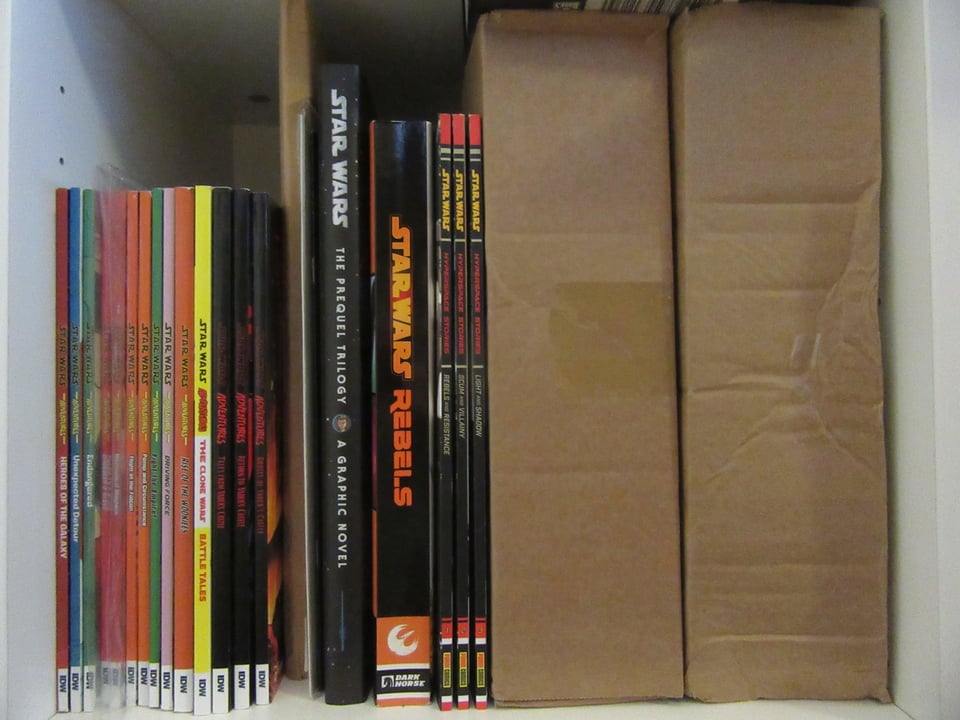
Star Wars Adventures was the main comic series by IDW, that released in two runs from 2017-2022. Each individual issue contained two stories, that were gathered together into whole tales in each TPB (trade paperback) volume, created by a whole host of amazing writers and artists - too many to name really!
I’m missing one volume of the eleven in the 2017-2020 series, but would really recommend them to Star Wars fans of any age/knowledge, as they’re a collection of fun and fast stand-alone stories with so many different fan-favourite characters. The frame story is set at the time of the sequel trilogy (including a descendent of the Grafs from the Adventures in Wild Space books), enabling stories to be told throughout the timeline. Volume 6 is part of the Flight of the Falcon event I mentioned in #4 of these posts.
The second series started post-lockdown, but was sadly cancelled with only one completed volume and twelve issues in total, plus some annuals.
The bright yellow spine is the special The Clone Wars - Battle Tales series, five individual issues written by Michael Moreci (lettered by Jake M. Wood) and collected in a single volume. Like with others in this series, there’s a frame story across all five, (pencilled and inked by Derek Charm with colours by Luis Antonia Delgado), then individual ‘battle tales’ that in this case clone commanders Rex, Cody and Wolffe tell each other to get through their current conflict. I automatically love any Clone Wars stories, but this was such a great focus on the clones, and each of their tales allowed a different art team to tell a short story within each issue.
I suppose if I’d actually arranged the shelf chronologically, that Clone Wars series would come first!
Either way, we’re onto Cavan Scott’s masterful Vader’s Castle series, Halloween spooky specials that paid homage to so many classic horror stories and originated that sort of Star Wars tall tales collection, set at Vader’s base first seen in Rogue One.
Tales from Vader’s Castle iconically began this 5 issue tales format, featuring a motley crew of rebels unknowingly sneaking into Vader’s castle and telling each other ghost stories to keep calm. It notably continues the story of the Graf siblings from Scott and Tom Huddlestone’s Adventures in Wild Space.
Then in the cardboard folder next to them are the two single issues in this series, the first being Droid Hunters, the 2019 Free Comic Book Day issue, a bonus story that fits between the action in the first five-parter.
Then we move onto Return to Vader’s Castle which does what a good sequel does - more of the same but better, with new angles, the stories instead told about villains by a villain. It’s like the second part of a duology.
Next is the standalone Shadow of Vader’s Castle, a long single issue that’s set after Vader’s death, following two of the native Mustafarians as they set out to explore what’s left.
This then leads into Ghosts of Vader’s Castle, the third series of five issues, following the same pattern but with ghostly dreams haunting those who visited the castle. The series also features Cavan Scott’s favourite character, Jaxxon the green talking rabbit, as a regular!
The next very slim comic on the shelf is Cav’s most recent story, which was a Celebration-exclusive Hyperspace Stories Annual—Jaxxon 2023 for Dark Horse who took over from IDW. I’m yet to open this New Republic era story, pencilled by Nick Brokenshire, coloured by David Kennedy and lettered by Comicraft.
The Prequel Trilogy - A Graphic Novel does what it says on the tin. The little lightsaber on the spine tells you this 208-page graphic novel was released by Disney-Lucasfilm Press. Alessandro Ferrari adapted all three films, aided by a whole host of amazing artists.
The massive Rebels omnibus released by Dark Horse collects the comic short stories from Star Wars: Rebels Magazine #1-#35, #37 and #39 by Titan/Panini and Star Wars: Rebels Animation Magazine #1-#4 from Panini in Germany I think. There’s something special about having all the rare stories about that animated family of characters all together in a massive collection. I’m so glad they did that. This omnibus also has on original story about Captain Rex by Alec Worley, whose craft newsletter I’d really recommend.
Then we come to Dark Horse’s Hyperspace Stories. Each issue of the twelve was a standalone story, but together they reveal the interesting tale of one artefact. That’s what a Panini editor told me, anyway, the company that distributes these in the UK and elsewhere. I got the whole collection in one go at MCM Comic Con in May. Starting next year, Dark Horse will be moving to graphic novels instead of single issues, each one focussing on a different character.
And in those cardboard boxes? My limited edition signed sprayed edge Inkstone Books copies of The Living Force by John Jackson Miller and Rise of the Red Blade by Delilah S. Dawson. I actually met Brett, one of the folks behind Inkstone, at Worldcon in Glasgow.
Next time we’ll launch into the first half of the many Star Wars Marvel comics series…
In Mumbai, Maharashtra, India…
Like before, my short story’s set in a city, not the location of the site. In fact the site I’m talking about today is far, far away from where my story, Ancient Army, begins.
The rock shelters of Bhimbetka are a world heritage site, the earliest traces of human life in India, with cave art from Mesolithic to Medieval, an incredible timeline of history. The site’s within the Ratapani Wildlife Sanctuary, in the sate of Madhya Pradesh. It’s an amazing forested, rocky area, a whole sprawling natural art gallery, a secluded exhibit curated by the best over thousands of years, from the earliest of prehistoric gods to possible Hindu deities.
There’s hundreds of rock shelters, only really known by modern archaeologists in their scale of time and space in the last fifty years. There’s evidence in some of the caves of occupation for thousands of years, and people continued coming back to the site while soldiers rode elephants and horses, all dated by various artefacts and paint pigments.
A brief bestiary of the site’s 1,377 animal depictions: lions, tigers, leopards/panthers, cheetah, rhinoceros, buffalo, bulls, cows, calves, bison, nilgai (blue bulls), chinkara (Indian gazelle), black buck, sambhar deer, barasingha (swamp deer), goats, sloth bear, wild boar (some more mythical looking)…
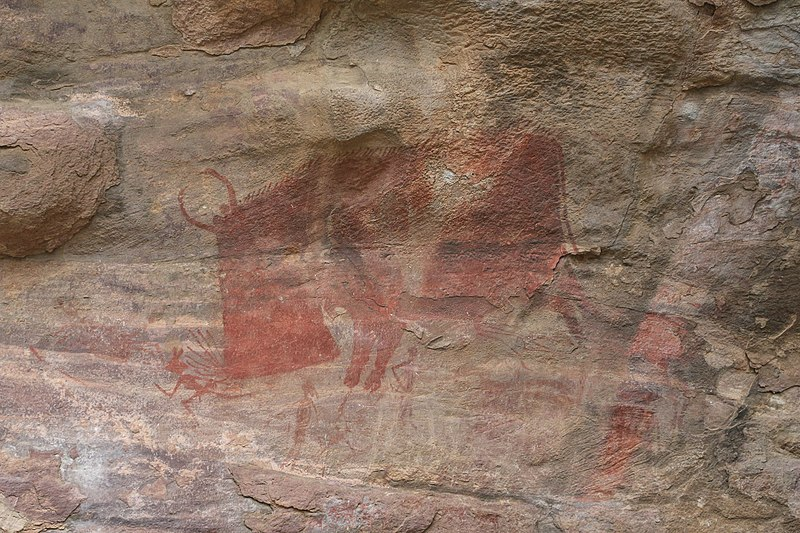
…hyena, wolf, dogs, langur monkeys, a monkey with a red face, elephants, horses, anteater, rabbits, squirrels, rats, lizard, frog, turtle, fish, crab, scorpion, jungle fowl, peafowl, spoonbill and magpie, and many humans that outnumber all of the above.
There’s hunting, fighting, family and dancing scenes, arms linked, as is the case in this potentially Mesolithic scene below:
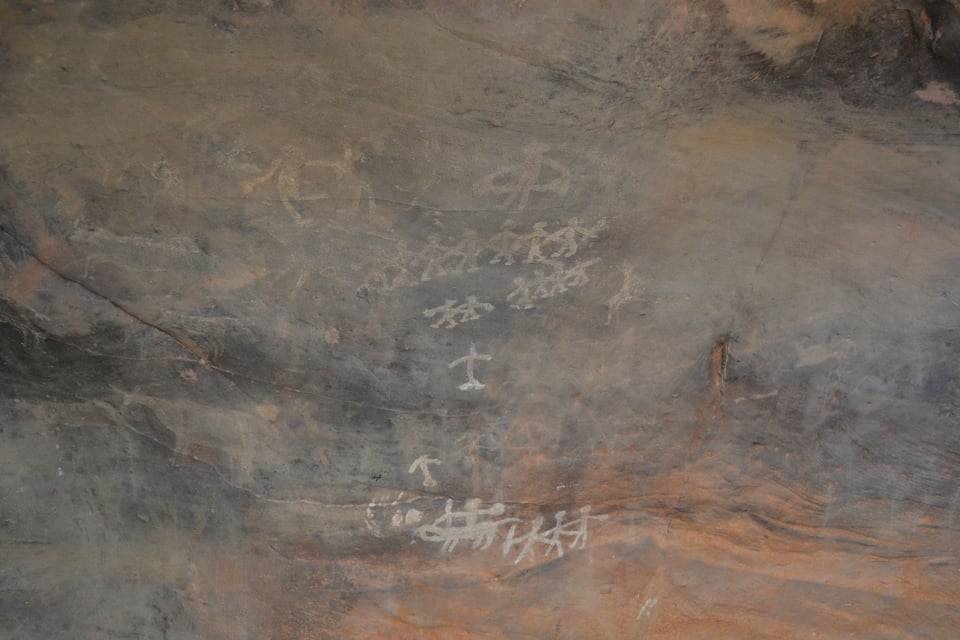
The earliest representations at the site are linear and in green paint, then come the smaller scenes of more people together, with hunting and potential tribal warfare scenes showing their different weapons.
Later Chalcolithic (copper age, something I only learned of recently) paintings give more insight into history of the local people meeting with agricultural communities, then we get into the historic stuff.
Painting from then on are mainly red, with some white and yellow, with many riders, symbols, clothes and different languages, including an undeciphered script.
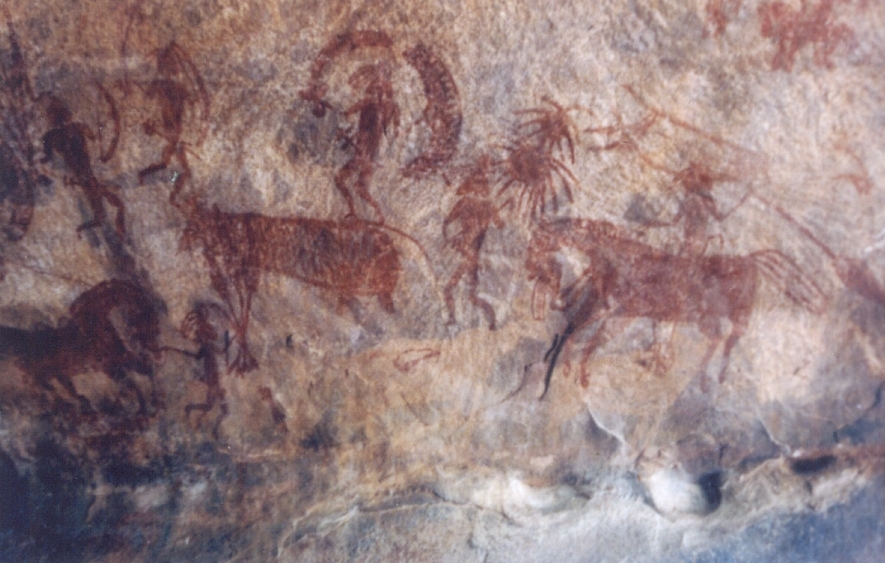
As well as mythical animals, there are also supposed figures from both the prehistoric and more defined beliefs in India. I was quite imaginative in my story without really seeing the art, writing about a potential more magical sky chariot:
The first chariot is like a bright cloud, white light, like a halo of floating moisture dancing rings in sunlight as it morphs and moves. It is self-propelled by some magic, a main carriage of cloud-gem-metal with silver lining and twisters of the same material rising in the back two corners, if the cloud-shape can be said to have corners. They form a small roof, as if an ancient manmade chariot, but the wheels, the wheels are whirlpool-wonders, bright rotating rings of invisible planets that barely seem to roll on the road surface. The whole substance has an inner light of being.
There was also mentions of tree gods and yaksha nature spirits, so I did some research and described them thusly (I thought I’d throw in that word for a change.):
short and somewhat rotund yet fierce in their own way: their mouths constant neutral smiles. They wear simple headdresses and long clothes from the waist down, but the brown cloth is as if fabric bark, these jolly stewards of the Earth, the soil’s treasure-keepers, little green men, with full bellies and eyes like knots in trees, blossoming nature’s guardians personified in yakshas…
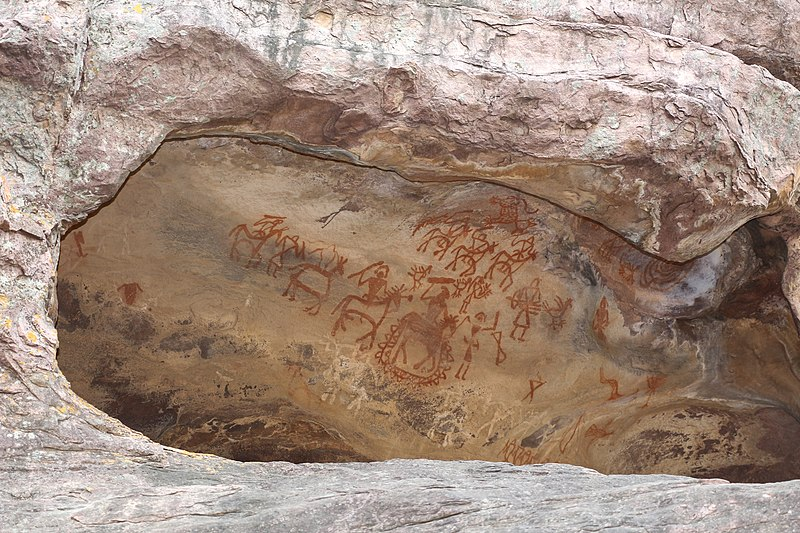
In the above photo, you can see riders with weapons in a procession, figures with bows, drums and some creatures too. It’s from a specific shelter known as zoo rock as sixteen different species are depicted amongst 400 figures superimposed over ten layers.
It’s the same throughout the site too, with the art broadly related to hunting/gathering or the more historic soldiers. There’s people with spears, others catching fish and a turtle in a net. The rats I mentioned are depicted driven out of their burrows.
It’s the depictions of all the different armies with their different weapons, clothes and mounts that inspired me though, to think of that history of swords and shields and armour being recorded at this site where people thousands of years before used stone tools.
My description of the army:
…a mish-mash crowd of so many different peoples… Some at the sides carry drums of all sorts. Some carry palm-like banners, or big outward-curving shields and scimitars, swords or daggers, or rectangular shields, or oval shields, elongated or rounded of all different materials, buffalo and rhino hide, strengthened at the edges, smoothed and polished, with four iron bosses, or copper or brass, floral colours, rich patterns, or smaller metal parrying shields, details in gold, cloth, velvet, or spears, or battle axes, or simple bows and arrows, or longer bows, or prehistoric bows. Some wear cloth, blouses, tunics, jackets, bands, turbans, longer hats … crescent headdresses or have hair loosely flowing, armour of metal or animal shells or ivory. Some are clearly more ancient hunters and not soldiers. Some have barbed spears, pointed sticks, carry animal totems or have painted their body with lines of paint.
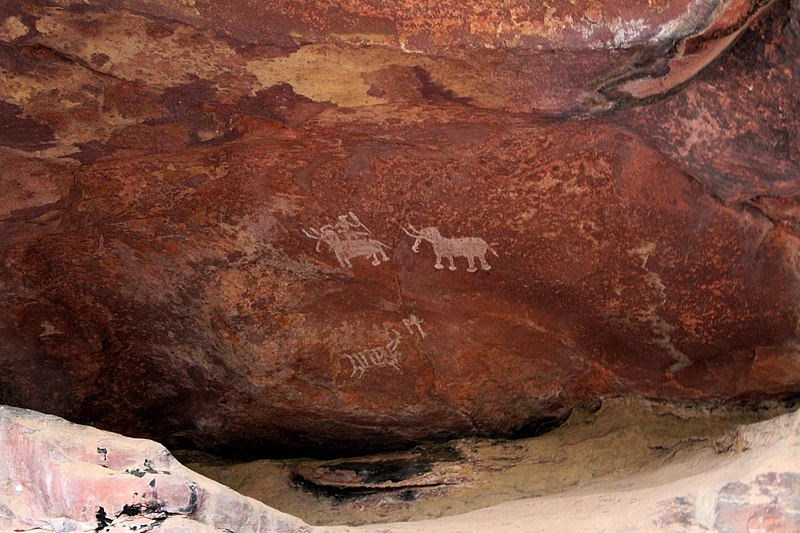
The best part of this varied army is the elephant riders! I got more imaginative looking at more realised depictions from stone reliefs. I’m sure I came across other artwork from the site, though, which I can’t find/share today, of red painted artwork with more of a decorated platform and riders.
As well as researching the ancient army, museums and online resources really aided my deep dive into describing what another chariot could look like if the 2-D art was realised as something similar to more modern religious imagery:
The second chariot is not just filtered sunlight, it is sunlight, it is glowing golden, a temple-vehicle, a golden platform on star-wheels, celestial gold, gold, gold, burning with feather-flames, a flying platform hovering like an indecisive shooting star, like a sun afraid of its stalking material planets. Gleaming.
The chariot has golden rods in each corner, a blazing uniformity with a whole roof, with a roof of many temple-layers, as if … transformed by subconscious alchemists into seven tiered plates of patterned gold above a throne that can fit three standing deities.
“Three deities?” I hear you ask.
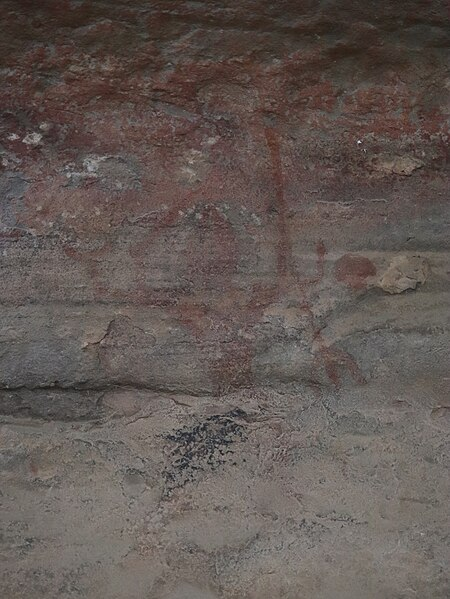
That’s because the Bhimbetka rock shelters may have early representations of Hindu gods, like the dynamic headdress-wearing figure above. I did a deep dive into other depictions of Shiva to try and work out what he could be holding. Some more quotes to describe what could be pictured above:
Four arms! He stands in cosmic-dance-meditation, legs splayed, left leg bent and in front of his right, four arms slowly shifting like time-lapse petals in the wind, unreality, ascetic, abstaining from indulgence and pleasure, finding happiness in the calm.
his lower right hand, clutches what can only be described as a shrunken moon. It is not-rock, a perfect glowing crescent…
…in his upper right hand he holds a parashu, a divine battle axe, small, elegantly clutched with a few fingers…
In his upper left hand, Shiva grips tightly the long shaft of his trishul, his golden trident, an ancient symbol, a sharp spear tip in the centre, and two curving prongs like long bull’s horns on either side…
Shiva’s free hand is curled like a bowl. His ashy palm kindles a magic flame. It hovers there, divine fire, destruction in a flickering, steepled orb of heat-power. Fire-bearer.
Maybe you can tell how much I enjoyed learning about the fascinating Hindu religion. There was also mention of a mother goddess depiction at the site, so I did some research into those early depictions and beliefs within India. But let’s move onto our third deity…
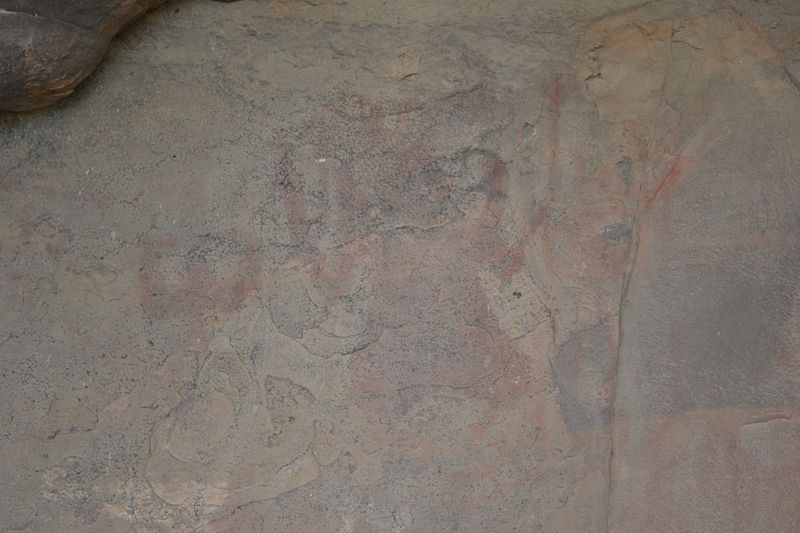
…the elephant-headed Ganesha.
Again, I certainly did a deep dive to describe the figure above, if Ganesha is indeed what that faded red represents.
God of good fortune, he stands there slightly squatted, a little like a frog, balancing as if in meditation. … full belly … with his symbol-relics, with four arms, with every meaningful detail from the minds of his artists coalesced into a figure of dream perfection, something alien yet so resonant, a multitude myth.
I learned that there were thirty-two well-known forms of Ganesha, with different arms/heads/objects/poses. But the painting above seemed like some ancient thirty-third form.
His face, his elephant head, is like some friendly, fierce, fruit-on-a-stalk shape, mass of life that is somehow a part of his human body, attached seamlessly by the invisible threads of legends, larger than a human’s head, yet smaller than a real elephant’s, some divine middle ground.
I then re-learnt some of the Hindu stories I once heard in RE classes in primary school, like the story of his birth and his family. (Shiva’s kind of his adoptive dad?) I also took some inspirations from certain depictions.
Over the dome of his elephant skull he wears a similar golden headdress to his father, more of a crowning helmet that sits above his ears. Beautiful, gilded patterns in the god’s garb rival the intricacies of his muscular trunk, swaying a little to one side and curved up towards his left shoulder.
This Ganesha also holds a trishul like his father, only with a shorter shaft. … His bottom left hand is free to gesture out. He holds his palm outwards…
In his top right hand is a small hand axe similar to that of his father’s… curved like a crescent. …like a divine elephant goad. Ganesha’s lower right hand holds a long bundle of golden rope… A pasha… represents his power to bind and remove obstacles.
Maybe I went a bit over the top with the quotes this time, but they’ll make up for the lack of any quotes from now on.
We’ve reached the end of this exploration of a long time ago. I hope you enjoyed! I really appreciate the opportunity to share these two facets of my reading/writing life. Thank you for supporting me on this endeavour!
Harvey
